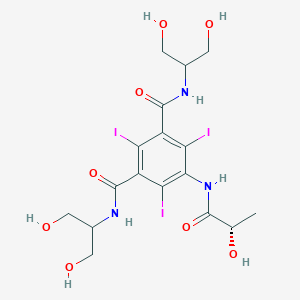Cerebral arteriography
Adult: As 300 mg iodine/mL solution (61%): 8-12 mL by carotid puncture or transfemoral catheterisation, with total multiple doses ranging to 90 mL. Dosage recommendations may vary among countries or individual products. Refer to specific product guidelines.
Intra-arterial
Coronary arteriography and ventriculography
Adult: As 370 mg iodine/mL solution (76%): 2-10 mL for selective coronary artery inj; 25-50 mL for ventriculography or nonselective opacification of multiple coronary arteries following inj at the aortic root. Max total: 200 mL. Dosage recommendations may vary among countries or individual products. Refer to specific product guidelines.
Intra-arterial
Peripheral arteriography
Adult: As 300 mg iodine/mL solution (61%): Femoral or subclavian artery: 5-40 mL. Aorta for a distal runoff: 25-50 mL. Max total: 250 mL. Dosage recommendations may vary among countries or individual products. Refer to specific product guidelines.
Intra-arterial
Selective visceral arteriography or aortography
Adult: As 370 mg iodine/mL solution (76%): Larger vessels e.g. aorta or coeliac artery: Up to 50 mL. Renal artery: Up to 10 mL. Max total: Up to 225 mL. Dosage recommendations may vary among countries or individual products. Refer to specific product guidelines.
Intrathecal
Computed tomographic cisternography
Adult: As 200 mg iodine/mL solution (41%): 4-6 mL via lumbar inj. Dosage recommendations may vary among countries or individual products. Refer to specific product guidelines.
Intrathecal
Myelography
Adult: Lumbar or thoracic: As 200 mg iodine/mL solution (41%): 10 to 15 mL. Cervical: As 200 mg iodine/mL solution (41%): 10-15 mL via lumbar inj or 10 mL via lateral cervical inj; As 300 mg iodine/mL solution (61%): 10 mL. Total columnar myelography: As 300 mg iodine/mL solution (61%): 10 mL. Doses are given via slow inj over 1-2 minutes. Dosage recommendations and route of administration may vary among countries or individual products. Refer to specific product guidelines.
Child: Lumbar or thoracic: As 200 mg iodine/mL solution (41%): 2-7 years 7-9 mL; 8-12 years 8-11 mL; 13-18 years 10-12 mL.
Child: Lumbar or thoracic: As 200 mg iodine/mL solution (41%): 2-7 years 7-9 mL; 8-12 years 8-11 mL; 13-18 years 10-12 mL.
Intravenous
Excretory urography
Adult: As 250 mg iodine/mL solution (51%): 50-100 mL. As 300 mg iodine/mL solution (61%): 50 mL. As 370 mg iodine/mL solution (76%): 40 mL. Doses are administered via rapid inj. Dosage recommendations may vary among countries or individual products. Refer to specific product guidelines.
Child: As 250 mg iodine/mL solution (51%): 1.2-3.6 mL/kg (Max: 120 mL). As 300 mg iodine/mL (61%): 1-3 mL/kg (Max: 100 mL). Dosage recommendations may vary among countries or individual products. Refer to specific product guidelines.
Child: As 250 mg iodine/mL solution (51%): 1.2-3.6 mL/kg (Max: 120 mL). As 300 mg iodine/mL (61%): 1-3 mL/kg (Max: 100 mL). Dosage recommendations may vary among countries or individual products. Refer to specific product guidelines.
Intravenous
Angiocardiography
Child: As 370 mg iodine/mL solution (76%). Single inj: <2 years 10-15 mL; 2-9 years 15-30 mL; 10-18 years 20-50 mL. Cumulative inj: <2 years 40 mL; 2-4 years 50 mL; 5-9 years 100 mL; 10-18 years 125 mL. Doses may be administered via inj into a large peripheral vein or via direct cardiac catheterisation.
Intravenous
Computed tomography imaging
Adult: Head: As 250 mg iodine/mL solution (51%): 130-240 mL. As 300 mg iodine/mL solution (61%): 100-200 mL. Body: As 250 mg iodine/mL solution (51%): 130-240 mL. As 300 mg iodine/mL solution (61%): 100-200 mL. Doses are given via rapid infusion or bolus inj. Dosage recommendations may vary among countries or individual products. Refer to specific product guidelines.
Child: Head and body: As 250 mg iodine/mL solution (51%): 1.2-3.6 mL/kg (Max: 120 mL). As 300 mg iodine/mL solution (61%): 1-3 mL/kg (Max: 100 mL). Dosage recommendations may vary among countries or individual products. Refer to specific product guidelines.
Child: Head and body: As 250 mg iodine/mL solution (51%): 1.2-3.6 mL/kg (Max: 120 mL). As 300 mg iodine/mL solution (61%): 1-3 mL/kg (Max: 100 mL). Dosage recommendations may vary among countries or individual products. Refer to specific product guidelines.
Intravenous
Peripheral venography
Adult: As 200 mg iodine/mL solution (41%): 25-150 mL per lower extremity. Max total for multiple inj: 350 mL. As 300 mg iodine/mL solution (61%): 15-100 mL per lower extremity. Max total for multiple inj: 230 mL. Dosage recommendations may vary among countries or individual products. Refer to specific product guidelines.
Oral
Computed tomography imaging
Adult: Abdomen: As 61.24% solution: 100 mL of a 17% dilution, or up to 600 mL of a 3% dilution.
Oral
Diagnostic aid in the radiologic examination of the gastrointestinal tract
Adult: As 61.24% solution: 40-100 mL (undiluted).
Child: As 61.24% solution: 10-100 mL (undiluted), or 20-200 mL of up to a 50% dilution for infants.
Child: As 61.24% solution: 10-100 mL (undiluted), or 20-200 mL of up to a 50% dilution for infants.
Rectal
Diagnostic aid in the radiologic examination of the gastrointestinal tract
Adult: As 61.24% solution: 200 mL of a 50% dilution, or up to 1,000 mL of a 2% dilution.
Child: As 61.24% solution: 200 mL of 50-60% dilution.
Child: As 61.24% solution: 200 mL of 50-60% dilution.
Rectal
Computed tomography imaging
Adult: Pelvis: As 61.24% solution: 500-700 mL of a 3% dilution.




 Đăng xuất
Đăng xuất


